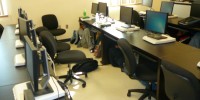Get Ready to Shake It Out!

Students and faculty at Three Rivers College are going to “Shake It Out” next Thursday, Oct. 16.
No, it’s not a new dance craze. It’s part of a statewide effort to prepare the campus and the rest of the state for an earthquake.
Jack Armor, Fire Training Coordinator for TRC says scientists can say with certainty that there is an earthquake in our future in Southeast Missouri. The question is only “when” and “how big will it be?”
Armor said Three Rivers has participated in the event in the past, but he considers this year’s event an important one for gauging the college’s earthquake readiness.
“Everyone on this campus will participate, and everyone on each of the satellite campuses will participate,” said Armor. Three Rivers now operates satellite campuses in several towns throughout Southeast Missouri, including Kennett, Dexter, Malden, Piedmont, Sikeston, Cape Girardeau, and Willow Springs.
The Poplar Bluff campus is now integrated into the emergency warning siren system that operates throughout Poplar Bluff. Armor said the sirens will not be used for this event on campus, but a verbal warning system to go out over the school’s public address system will be used.
“This drill will be held at 10:16 a.m. on October 16. One of the things we want to check is whether or not everyone can hear the PA system in their classrooms,” explained Armor. He said students and personnel will be instructed to “Drop, Cover, and Hold On.”
“That is the first step for safety in an earthquake,” said Armor. “Most people hurt or killed during an earthquake sustain their injuries from things falling on them.”
He said the first course of action in an earthquake is to get under something heavy that can protect you, then become aware of your surroundings. “Look for anything that could fall on you, and always protect your head,” added Armor.
He said public buildings built during recent years are built to be as resistant to earthquakes as possible, but there is no such thing as “earthquake proof.”
“We want people to be as safe as possible,” said Armor. But, that is just the beginning in a real earthquake scenario. “Then it is about getting into a safe place, making sure everyone is accounted for, and getting people the help they need.”
One of the things he tells both students and personnel is to NOT use their cell phones following an emergency. “That can actually jam cell phone service and make it harder for emergency personnel to get to the scene.”
He says that safety in such a scenario requires the help of everyone, from instructors, personnel, and students. And safety is not just an issue for a college campus, reminded Armor.
“Every family should also be prepared,” he said. He recommends having an easy-to-grab emergency kit, such as in a backpack kept near an exit door.
Emergency kit contents are an easy Internet search away: emergency kit earthquake.
“Phones will be out. Gas lines will have leaks, water lines will break. Bridges will be out. Roads will be torn up. You have to be prepared for the worst conditions,” explained Armor.
Other advice is to stay inside if possible during and after an earthquake, and do not attempt to use elevators. Stay away from windows and large glass objects. Watch out for heavy objects which are likely to fall, like lights, shelves, and appliances. Those outdoors should move away from trees, power lines, buildings and walls.
- TRCC Earthquake Readines
- TRCC Earthquake Readines


